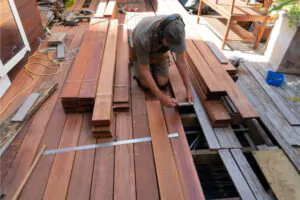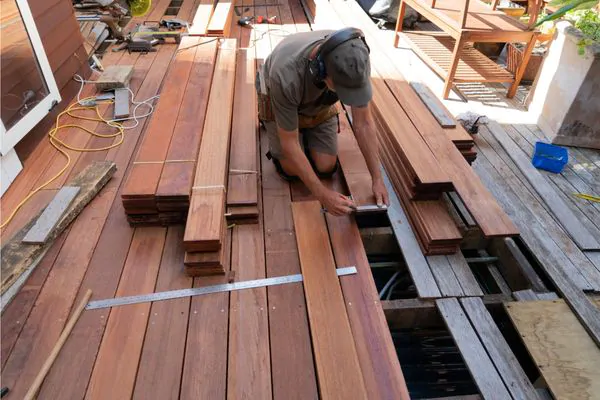Are you torn between building a deck or a patio? You’re not alone. Many homeowners puzzle over this choice when planning to boost their outdoor living space, whether to install a patio or build a deck. The big question is often: “Is a deck cheaper than a patio?” It’s a key factor in making the right call for your home and budget.
Let’s clear the air about the differences between a deck and a patio. On average, a deck costs about $7,900 to build, while a patio runs around $3,800. But there’s more to consider than just price. This guide will walk you through the pros and cons of decks and patios.
We’ll look at costs, durability, and design options for both deck materials and patios to help you decide. Ready to find your perfect outdoor space?
Key Takeaways
- Decks cost more to build than patios, with average prices of $7,900 for decks and $3,800 for patios.
- Decks offer a higher return on investment at about 70%, compared to 50% for patios.
- Patios require less maintenance over time, while wood decks need regular sealing and staining.
- Concrete patios can last 25-50 years, while wood decks typically last 10-20 years with proper care.
- Both options offer design flexibility, with decks providing raised platforms and patios blending into the landscape.
Understanding Decks and Patios
Decks and patios are popular outdoor living spaces that add value to homes. A deck is a raised platform attached to a house, while a patio is a ground-level area often made of concrete or pavers.
Definition of a Deck
A deck is an outdoor platform attached to a house. It sits above ground level and extends living space outdoors. Decks are usually made of wood, composite materials, or metal.
Decks offer a raised surface for relaxing, dining, or entertaining. They work well on sloped or uneven terrain where patios might not fit. In Colorado, decks are popular choices for homes with mountain views or challenging landscapes.
A well-built deck is like adding an outdoor room to your home.
Most decks connect directly to a home’s main level or second story. This creates a smooth transition between indoor and outdoor areas. Railings often surround decks for safety, especially on higher structures.
Some decks include built-in seating, planters, or storage to maximize space.
Definition of a Patio
A patio is an outdoor living space built flush with the ground. It offers a flat, stable surface for relaxation and entertainment. Patios use materials like concrete, brick, tile, or stone.
These options provide durability and low maintenance.
Patios require level ground for proper installation. This makes them ideal for homes with even terrain. Unlike decks, patios don’t need permits in most areas. They also don’t have height restrictions.
Patios blend seamlessly with the landscape, creating a natural flow between indoor and outdoor spaces.
Concrete patios are popular in Colorado due to their strength and versatility. They withstand harsh weather and need little upkeep. Brick and stone patios add charm and character to homes.
These materials offer slip resistance, making them safe for wet conditions. Patios can include features like fire pits, outdoor kitchens, or water features for added enjoyment.
Analyzing the Costs of Decks vs. Patios
Decks and patios come with different price tags. We’ll break down the costs to help you choose the best option for your budget.
Comparing Initial Installation Costs
Initial costs for decks and patios differ greatly. Decks average $7,900, while patios cost about $3,800. Per square foot, decks run around $9, but patio costs vary. Brick patios cost $6 per square foot, concrete $4, and stamped concrete $12.
A well-built deck or patio adds value to your home and enhances outdoor living.
Material choice impacts the final price tag. Wood decks need regular upkeep, raising long-term costs. Concrete patios last longer with less maintenance. Your budget and lifestyle will guide your choice between a deck or patio.
Evaluating Long-term Maintenance Costs
Long-term upkeep costs play a big role in choosing between a deck and patio. Decks need regular care to stay in good shape. Wood decks require sealing and staining every few years to protect against rot and weather damage.
Composite decks cost more upfront but need less care over time. They don’t need staining or sealing, just occasional cleaning.
Patios have lower maintenance needs overall. Concrete patios may crack over time and need repairs. Paver patios might need resetting if the ground shifts. Both types need regular cleaning to remove dirt and debris.
Pressure washing once or twice a year keeps patios looking fresh. In Colorado’s climate, snow removal is also part of patio upkeep in winter months.
Comparing Durability and Lifespan
Decks and patios differ in how long they last. Their durability depends on materials, weather, and upkeep.
Durability and Life Expectancy of Decks
Decks offer varying lifespans based on their materials. Wood decks typically last 10-20 years with proper care. They need regular sealing and staining to protect against weather damage.
Composite decks boast longer durability, often reaching 25-30 years or more. Some high-quality composite options can even last up to 50 years. These decks resist rot, warping, and insect damage better than wood.
They also require less upkeep, needing only occasional cleaning to maintain their appearance.
Your deck’s lifespan depends on several factors beyond material choice. Climate plays a big role, with harsh Colorado winters potentially shortening a deck’s life. Regular maintenance, quality of installation, and usage patterns also impact durability.
Proper care can extend your deck’s life, while neglect can lead to early replacement needs. Consider these factors when choosing between wood and composite for your Colorado home.
Durability and Life Expectancy of Patios
Patios stand the test of time. With proper care, they can last for decades. Unlike wooden structures, patios resist rot, warping, and insect damage. Concrete and stone patios handle Colorado’s harsh weather well.
They don’t need frequent staining or sealing like decks do.
A well-built patio offers great value. It can last 25 to 50 years or more. The cost varies based on materials. A plain concrete patio averages $3,274, while stamped concrete runs about $4,664.
These durable outdoor spaces need little upkeep, saving you money long-term.
Exploring Aesthetic and Design Flexibility
Decks and patios offer unique design options. You can customize your outdoor space with different materials, colors, and layouts to match your style.
Design and Customization Options for Decks
Decks offer endless design possibilities. You can choose from a wide range of materials, including redwood and cedar. Redwood costs $4 to $6 per square foot, while cedar ranges from $4 to $9.
These natural woods provide a classic look and can be stained in various shades to match your home’s style.
Customization goes beyond materials. You have the freedom to shape your deck to fit your space and needs. Whether you want a simple rectangular platform or a multi-level outdoor living area, the options are vast.
Add built-in seating, planters, or even a pergola to create a unique outdoor retreat. With so many choices, your deck can truly reflect your personal taste and lifestyle.
Design and Customization Options for Patios
Patios offer a wide range of design options to suit your taste and home style. You can choose from various materials like concrete, pavers, or flagstone. Each material brings its own look and feel to your outdoor space.
Flagstone patios cost between $750 and $8,400, while bluestone options range from $4,608 to $7,200, with an average of $6,048.
Customization doesn’t stop at materials. You can add features like built-in seating, fire pits, or outdoor kitchens to make your patio more functional. Landscaping around the patio can also enhance its appeal.
Plants, rocks, and lighting can create a unique outdoor living area that fits your needs and budget.
Assessing Return on Investment
Return on investment matters for both decks and patios. A well-built deck or patio can boost your home’s value and appeal to future buyers.
Estimating ROI for Decks
Decks offer a solid return on investment for homeowners in Colorado. Research shows deck installations yield about 70% ROI, outperforming patios by roughly 75%. This means a $9,000 deck could add $7,500 to your home’s resale value.
The high ROI stems from decks’ popularity among buyers and their ability to expand usable outdoor space.
Several factors influence a deck’s ROI. The materials used, design quality, and local market conditions all play a role. Wood decks often provide the best returns due to their lower upfront costs and natural appeal.
Composite decks, while pricier, can offer long-term value through reduced maintenance needs. Professional installation also boosts ROI by ensuring proper construction and safety standards.
Estimating ROI for Patios
Patios offer a solid return on investment for homeowners. Industry data shows patio installations typically yield about 50% ROI. This means a $3,500 patio project could add around $1,500 to your home’s resale value.
The exact return varies based on factors like materials, design, and local market conditions.
Concrete patios often provide the best bang for your buck. They’re durable, low-maintenance, and appeal to many buyers. Stone or brick patios may cost more upfront but can boost curb appeal and longevity.
To maximize ROI, focus on creating a functional outdoor living space that fits your home’s style. Add features like built-in seating or a fire pit to enhance the patio’s value and appeal.
Conclusion
Decks and patios both offer unique benefits for your outdoor space. Your choice depends on your budget, terrain, and personal style. Decks provide a higher return on investment and work well for uneven yards.
Patios cost less upfront and need less upkeep over time. Consider your specific needs and consult a pro to make the best choice for your home. Your perfect outdoor oasis awaits!
FAQs
1. Which is cheaper to build: a deck or a patio?
Generally, patios are cheaper to build than decks. A concrete patio costs less than a wooden deck. The average deck costs more due to materials and labor. However, the final price depends on size, materials, and design.
2. What’s the main difference between decks and patios?
The key difference is elevation. A deck is raised and attached to the home, often requiring stairs. A patio sits at ground level. Decks use wood or composite materials, while patios typically use concrete, pavers, or stone.
3. How do maintenance costs compare for decks and patios?
Decks need more upkeep. Wood decks require regular staining and sealing to prevent rot. Composite decks need less care but still need cleaning. Patios are low-maintenance, needing occasional cleaning and sealing for concrete or pavers.
4. Which option offers better ROI: a deck or a patio?
Decks often provide a higher return on investment (ROI) for home improvement. A new deck can boost home value more than a patio. However, ROI varies based on location, design, and market trends.
5. Are there any height restrictions for building a deck or patio?
Decks may face height limits set by local building codes, especially for elevated structures. Patios don’t usually have height restrictions since they’re ground-level. Check with your local authorities for specific rules.
6. Can I install a deck or patio myself to save money?
DIY patio installation is often easier and cheaper than building a deck. Deck construction requires more skill and tools. For safety and quality, hiring a professional deck builder is recommended, especially for raised decks.









